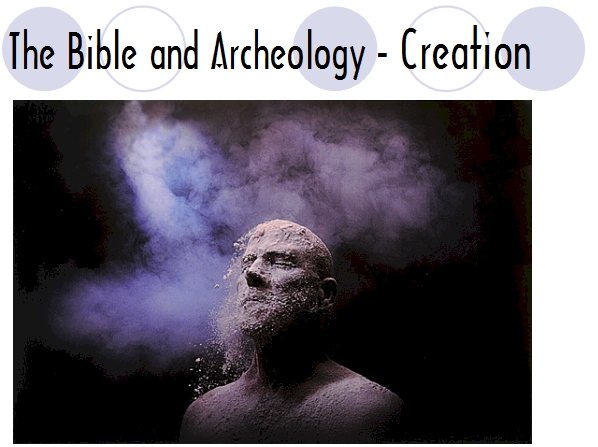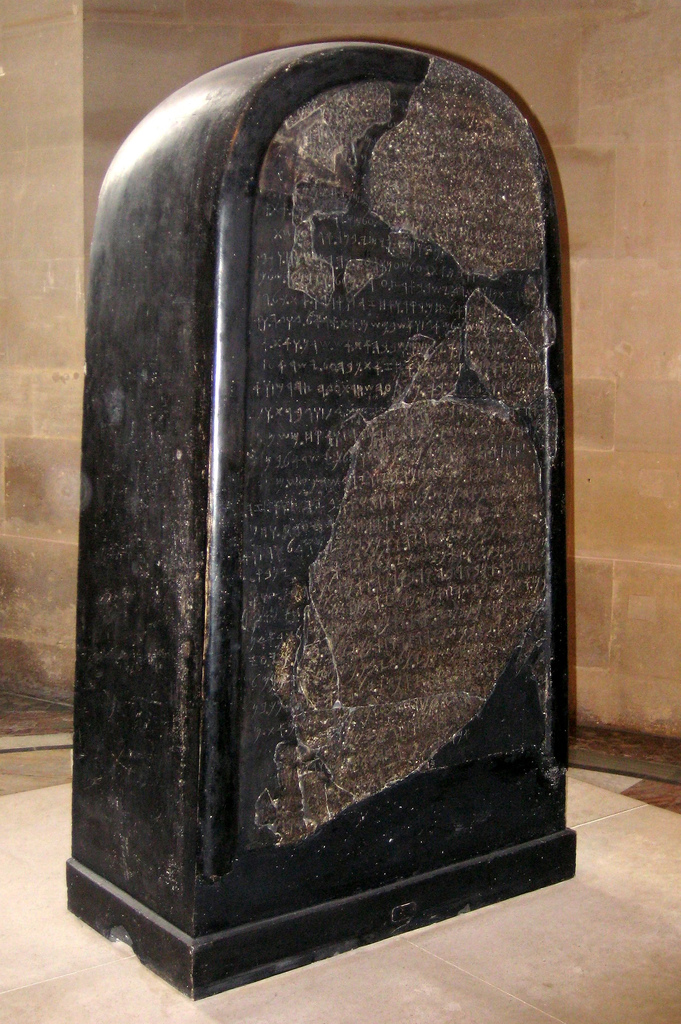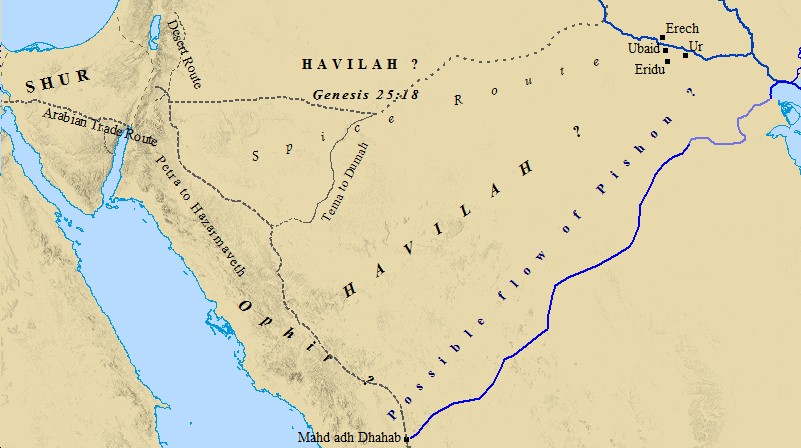|
DPS Biblical
Archeology Study Outline
2. Biblical Creation and Archeology
|

Download: Teacher's Script: (PDF)
(Word) |
Handout: (PDF) (Word) |
PowerPoint
Overview
a.
Inscriptions and Writings:
The Mesha Stele
(Moabite Stone)
b.
Scripture Reading: Genesis 1
c.
Comparing Genesis 1&2 to other Mesopotamian Creation accounts
d.
Archeological discovery from above: Pishon River?
Discussion Questions
_______________________________
a.
Inscriptions and Writings:
The Mesha Stele
(Moabite Stone)
 Popularized in the 19th century as the "Moabite Stone,"
the Mesha Stele is a black
basalt stone, bearing an inscription by the 9th century BC Moabite
King Mesha, discovered in 1868 at Dhiban (biblical "Dibon," capital of
Moab). The inscription of 34 lines is written in the Moabite language.
It is the most extensive inscription ever recovered that refers to
ancient Israel. It was set up by Mesha, about 850 BC, as a record and
memorial of his victories in his revolt against the Kingdom of Israel,
undertaken after the death of his overlord, Ahab. Popularized in the 19th century as the "Moabite Stone,"
the Mesha Stele is a black
basalt stone, bearing an inscription by the 9th century BC Moabite
King Mesha, discovered in 1868 at Dhiban (biblical "Dibon," capital of
Moab). The inscription of 34 lines is written in the Moabite language.
It is the most extensive inscription ever recovered that refers to
ancient Israel. It was set up by Mesha, about 850 BC, as a record and
memorial of his victories in his revolt against the Kingdom of Israel,
undertaken after the death of his overlord, Ahab.
The stele, which measures 44"x27”, describes:
1. How Moab was conquered by Omri, King of Israel, as the result of
the anger of the god Chemosh. Mesha’s victories over Omri’s son (not
mentioned by name), over the men of Gad at Ataroth, and at Nebo and
Jehaz;
2. His public buildings, restoring the fortifications of his strong
places and building a palace and reservoirs for water; and
3. His wars against the Horonaim.
This inscription can be interpreted as supplementing and corroborating
the history of King Mesha recorded in 2 Kings 3:4-27, thereby earning
it a prominent place in the corpus of Biblical archaeology. However
there are significant differences. In the Bible it is Ahab, Omri’s
son, who conquers Moab, and the rebellion is against Ahab’s son
Jehoram. Further, in the Bible, it is not Chemosh who gives victory to
Mesha but Jahweh who gives victory to Jehoram. Israel withdraws,
according to the Book of Kings, only because they are disconcerted
when they see Mesha sacrifice his son.
The Stele is also significant in that it mentions the Hebrew name
of God – YHWH. It is thought to be the earliest known reference to the
sacred name in any artifact.
b.
Scripture Reading: Genesis 1
(New
International Version (NIV))
1
In the
beginning God created the heavens and the earth.
2
Now the earth
was formless and empty, darkness was over the surface of the deep,
and the Spirit of God was hovering over the waters.
3
And God said,
“Let there be light,” and there was light.
4
God saw that
the light was good, and he separated the light from the darkness.
5
God called the
light “day,” and the darkness he called “night.” And there was
evening, and there was morning—the first day.
6
And God said,
“Let there be a vault between the waters to separate water from
water.”
7
So God made the vault and
separated the water under the vault from the water above it. And
it was so.
8
God called the vault “sky.”
And there was evening, and there was morning—the second day.
9
And God said,
“Let the water under the sky be gathered to one place, and let dry
ground appear.” And it was so.
10
God called the
dry ground “land,” and the gathered waters he called “seas.” And
God saw that it was good.
11
Then God said, “Let the land
produce vegetation: seed-bearing plants and trees on the land that
bear fruit with seed in it, according to their various kinds.” And
it was so.
12
The land produced
vegetation: plants bearing seed according to their kinds and trees
bearing fruit with seed in it according to their kinds. And God
saw that it was good.
13
And there was
evening, and there was morning—the third day.
14
And God said,
“Let there be lights in the vault of the sky to separate the day
from the night, and let them serve as signs to mark sacred times,
and days and years,
15
and let them be
lights in the vault of the sky to give light on the earth.” And it
was so.
16
God made two great
lights—the greater light to govern the day and the lesser light to
govern the night. He also made the stars.
17
God set them in
the vault of the sky to give light on the earth,
18
to govern the
day and the night, and to separate light from darkness. And God
saw that it was good.
19
And there was
evening, and there was morning—the fourth day.
20
And God said,
“Let the water teem with living creatures, and let birds fly above
the earth across the vault of the sky.”
21
So God created
the great creatures of the sea and every living thing with which
the water teems and that moves about in it, according to their
kinds, and every winged bird according to its kind. And God saw
that it was good.
22
God blessed
them and said, “Be fruitful and increase in number and fill the
water in the seas, and let the birds increase on the earth.”
23
And there was
evening, and there was morning—the fifth day.
24
And God said,
“Let the land produce living creatures according to their kinds:
the livestock, the creatures that move along the ground, and the
wild animals, each according to its kind.” And it was so.
25
God made the
wild animals according to their kinds, the livestock according to
their kinds, and all the creatures that move along the ground
according to their kinds. And God saw that it was good.
26
Then God said, “Let us make
mankind in our image, in our likeness, so that they may rule over
the fish in the sea and the birds in the sky, over the livestock
and all the wild animals, and over all the creatures that move
along the ground.”
27
So God created
mankind in his own image,
in the image of God he
created them;
male and female he created
them.
28
God blessed them and said to
them, “Be fruitful and increase in number; fill the earth and
subdue it. Rule over the fish in the sea and the birds in the sky
and over every living creature that moves on the ground.”
29
Then God said, “I give you
every seed-bearing plant on the face of the whole earth and every
tree that has fruit with seed in it. They will be yours for food.
30
And to all the
beasts of the earth and all the birds in the sky and all the
creatures that move along the ground—everything that has the
breath of life in it—I give every green plant for food.” And it
was so.
31
God saw all that he had
made, and it was very good. And there was evening, and there was
morning—the sixth day.
c.
Comparing Genesis 1 to other Mesopotamian
Creation accounts
In the beginning God created the heavens and the earth. (Genesis 1:1).
So begins the text of Genesis 1:1. Though it points back to the
creation of all things, it must be understood that this was not the
first thing ever to be written. There had already been many books
written before this time and some which dealt with the question of
creation.
Among the multitude of tablets found in the Library of Ashurbanipal in
Nineveh were a group of seven tablets known as the Enuma Elish. Though
the library dates only to the late 7th century B.C., the present form
of the epic itself goes all the way back to the days of Hammurabi
(1700 B.C.), while the story descends from the days of the Sumerians.
The Enuma Elish (“When on high”) draws its title from the first
sentence of its narrative: “When on high the heaven had not been
named, firm ground below had not been named…”
The text was found written on seven tablets; some see a parallel here
to the seven days in the biblical creation cycle.
* Tablet 1: Aspu and Tiamat come together to give birth to the
primitive forces and gods. However, Aspu turns against his offspring,
but is slain by them. Tiamat is enraged at the death of her husband
and she prepares to avenge his death.
* Tablet 2: Marduk, one of the second generation gods, is elected to
fight Tiamat.
* Tablet 3: The assembly of gods decrees the outcome of the battle and
the glory of Marduk.
* Tablet 4: They each create seven assistants to help them. Marduk
wins the conflict and dissects the body of Tiamat.
* Tablet 5: From the body of Tiamat, Marduk creates heaven and earth.
The moon and the stars are established to mark the seasons.
* Tablet 6: Tiamat’s second in command, Kingu, is slain and from drops
of his blood Marduk creates man so that there will be one to sacrifice
to the gods.
My blood will I take and bone will I fashion
I will make man, that man may be his name,
I will create man who shall inhabit the earth,
That the service of the gods may be established, and that their
shrines may be built.
But I will alter the ways of the gods, and I will change their
paths…..
* Tablet 7: Marduk advances from the chief god of Babylon to become
head of the entire pantheon. He is given 50 names representing the
power of the various deities.
Similarities and Differences with the Genesis Account
|
Similarities |
Differences |
|
(1) Both accounts speak of a time when the earth was without form
and void.
(2) Both accounts have a similar order of events in creation.
(3) Both accounts view humanity’s purpose to be worshiping
God/gods
(4) Both creation accounts relate humans to God above animals.
(5) The number seven seems significant in both accounts (seven tablets and seven days of creation). |
(1) The Enuma Elish features several gods (polytheistic) while
Genesis mentions only one God (though God refers to Godself in the
plural in Gen 1:28 "let us make humans" which many Christians
take as an OT proof text for the doctrine of the Trinity).
(2) While the Enuma Elish does not separate spirit and matter, the
Genesis account carefully distinguishes between the two.
(3) The Enuma Elish features conflict and
violence among all characters, including the gods, while Genesis
portrays violence as sinful and only occurring in the human
community. |
THE NATURE OF THE TWO CREATION ACCOUNTS
A reading of Genesis 1-2 will show immediately that we have two
separate and distinct accounts of creation.
|
GENESIS 1 |
GENESIS 2 |
|
The heavens and the earth are created in six days. |
Creation of the man and the woman (no time element mentioned). |
|
Shows humanity in its cosmic setting. |
Shows humanity as central to God’s purpose. |
|
A panoramic view of creation as a whole. |
A detailed view of one particular aspect of creation. |
|
Centers on God creating the heavens and the earth. |
Centers on humanity as the crowning of God’s creation. |
Rather than being contradictive, these two accounts are complimentary.
Indeed, this method of first giving a panoramic view and then coming
back to focus on important details is found all through Genesis.
THE SIX DAYS OF CREATION
The six days of creative work are topical in nature.
|
DAY 1: Light. |
DAY 4: Light-givers (Sun, moon & stars). |
|
DAY 2: Water & sky divided. |
DAY 5: Fish and birds. |
|
DAY 3: Land & Vegetation |
DAY 6: Land animals & man. |
The Jews delighted in this sort of parallelism – it was akin to
poetry.
d.
Archeological discovery from above: Pishon River?
And the Lord God planted a garden toward the east, in Eden; and there
He placed the man whom He had formed. (Genesis 2:8).
Now a river flowed out of Eden to water the garden; and from there
it divided and became four rivers. The name of the first is Pishon;
it flows around the whole land of Havilah, where there is gold. And
the gold of that land is good; the bdellium and the onyx stone are
there. And the name of the second river is Gihon; it flows around
the whole land of Cush. And the name of the third river is Tigris;
it flows east of Assyria. And the fourth river is the Euphrates.
(Genesis 2:10-14).
This passage has been a source of great confusion because it seems to
join geographical areas which are far removed from one another.
In the 1990′s, Boston University scientist Farouk El-Baz used photos
from satellites orbiting the earth and space Shuttle Imaging Radar to
locate an underground river which now runs under a portion of the
desert of Saudi Arabia (James A. Sauer, “The River Runs Dry,” Biblical
Archaeology Review, Vol. 22, No. 4, July/August 1996, pp. 52-54, 57,
64 and Molly Dewsnap, “The Kuwait River,” Biblical Archaeology Review,
Vol. 22, No. 4, July/August 1996, p. 55.).
In Kuwait, a dry riverbed (Wadi Al-Batin) cuts through limestone and
appears to disappear into the desert of Saudi Arabia. Actually, the
river ran underground along a fault line under the sand. From the Hyaz
Mountains in Saudi Arabia, this river carried granite and basalt
pebbles 650 miles northeast to deposit them at its delta in Kuwait
near the Persian Gulf.
Some have theorized that this lost river corresponds to biblical
descriptions of the Pishon River. This one discovery was enough to
make Sauer, the former curator of the Harvard Semitic Museum’s
archaeological collections, reverse his previous skepticism regarding
the historical accuracy of the Bible.
The last two rivers are known to us. The first two are not. However,
they come with geographical identifiers. This perhaps indicates that
they were not well known to the readers of this account as they are
not well known to us.
The location of the last two river points to a location for the Garden
of Eden at the northwest end of the Persian Gulf.

Discussion Questions:
How do you explain the
similarities between the ancient Middle Eastern creation accounts? Do
you believe that God's revealed truth to people other than our Jewish
forebears? Are the differences in the accounts significant in your
opinion? From the research presented here, you believe there is enough
indication that that the garden of Eden was a real place in our
geography and history? How important is it to your faith that the Garden
of Eden story is history rather than sacred story?
|